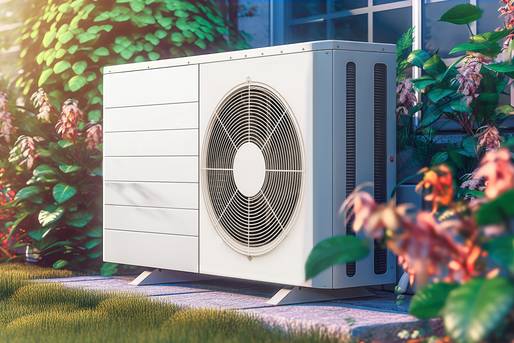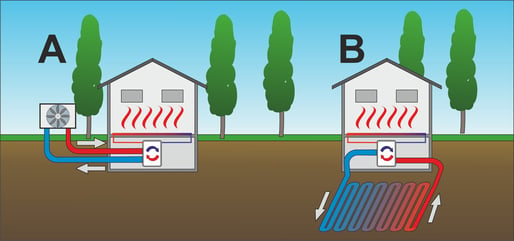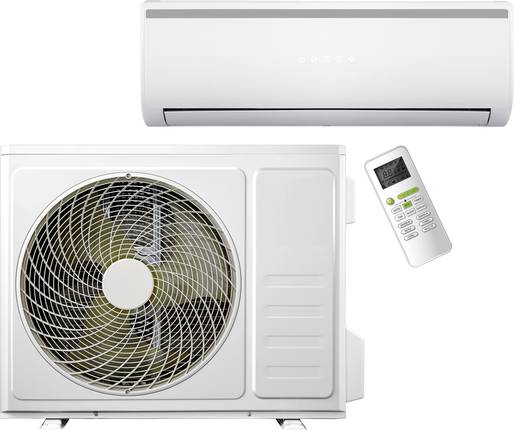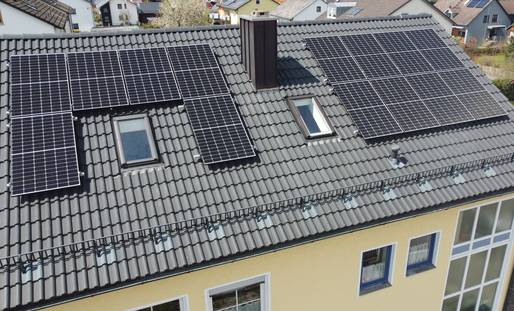Heat pumps » Heating with thermal energy from the environment
Published: 01.08.2023 | Reading time: 8 minutes
This text is machine translated.
Global warming, climate change, CO2 emissions and the greenhouse effect are dramatic-sounding buzzwords that can unfortunately be heard more and more often in the news.
It is therefore essential that greenhouse gases such as fluorinated gases, methane, nitrous oxide and carbon dioxide (CO2) are reduced. Carbon dioxide in particular, which many heating systems emit when burning fossil fuels such as coal, oil or natural gas, contributes to global warming and climate change, among other things.
For this reason, environmentally friendly or climate-neutral alternatives from renewable energies are urgently needed. When it comes to heating, the term “heat pump” comes up again and again. But what are heat pumps, how do they work and are they really the panacea for the climate crisis? We would like to answer these questions and provide you with further interesting information on this important topic.
There is plenty of heat in the air, in the earth and also in water, which could ideally be used for heating. The reason for this is solar radiation or the Earth's hot core. However, apart from the boiling geysers in Iceland, the available heat energy is unfortunately not directly suitable for heating. This is because during the heating season, the temperatures of the air, water or earth are often significantly lower than the required 20 degrees Celsius (°C), which the Federal Environment Agency recommends as the target room temperature.
It takes some technical know-how to ensure that the heating process still works and is efficient and environmentally friendly. For example, air-to-water heat pumps (1) are used to raise the existing thermal energy (2) in the air to a significantly higher level (3).
The high temperature or temperature increase achieved in this way is then transferred to the water circuit of a heating system (4). Individual rooms, entire buildings or even complete swimming pools can be heated easily and efficiently in this way.
The ingenious trick here is that a large part of the heating energy obtained comes directly from the environment. Only the electrical energy required for the pump (5), which is ideally generated from renewable energy sources, has a cost impact.
Heat pumps are not a new invention from the 21st century. No, heat pumps have been around for over 100 years. In principle, every refrigerator or freezer is a heat pump. The only difference is that these refrigerators use the temperature reduction generated in the interior and not the waste heat generated at the rear. To make it easier to understand how a heat pump works, let's first take a closer look at the function of a compressor refrigerator.
Function of a compressor refrigerator
A refrigerator has a closed cooling circuit containing a gaseous or liquid refrigerant, such as isobutane. Isobutane, or R600a, has a very low boiling point and evaporates at a temperature of -11.5 °C.
The gaseous refrigerant (1) is pressurized with the aid of a compressor (2), which is located outside the interior space to be cooled (outside). This heats the refrigerant to around 60 to 100 °C due to the Joule-Thomson effect. The hot and pressurized refrigerant is then fed to a cooling loop or heat exchanger (3) on the rear wall of the refrigerator. There, the heat energy is simply released into the ambient air.
As the boiling temperature of the pressurized refrigerant is significantly higher than -11.5 °C, it condenses in the cooling loop and becomes liquid. This is why experts also refer to the cooling loop as a condenser.
The liquid refrigerant then flows into the interior of the refrigerator (inside) via a capillary tube. The capillary tube serves as a throttle or expansion valve (4), which reduces the pressure and finely atomizes the refrigerant. The pipes of the downstream evaporator (5) provide sufficient space for the refrigerant to return to its gaseous state by reducing the pressure. The heat energy required for evaporation (evaporative cooling) is extracted from the interior of the refrigerator by the evaporator as a heat exchanger. After the evaporator, the gaseous refrigerant is fed back into the compressor so that the cycle can start again. The temperature is controlled by a thermostat, which switches the compressor on or off within a certain temperature range.
Function of a heat pump
A heat pump also contains a closed cooling circuit with refrigerant, two heat exchangers and a compressor. However, unlike a refrigerator, a heat pump uses the temperature increase and not the temperature decrease.
For this purpose, the gaseous refrigerant (2) is compressed with a compressor (1). The hot and pressurized refrigerant is fed to the first heat exchanger or condenser (3).
In addition to the pipes for the refrigerant, this heat exchanger also has pipes for a heating circuit (4).
Both pipe systems are thermally connected to each other. This allows the heat from the compressed refrigerant to be efficiently transferred to the heating circuit with heat distribution and storage system.
The cooled and now liquid refrigerant is passed via a throttle (5) to the second heat exchanger, the evaporator or heat source system (6). In addition to the pipes for the refrigerant, there are also thermally coupled pipes for the cooling circuit (7) in the evaporator. The cooling circuit is usually filled with antifreeze and water and can compensate for the cold produced during evaporation in the evaporator with ambient heat. In this way, the environment is cooled by a heat pump as a positive side effect. The refrigerant, which is now gaseous again, is fed to the compressor, which closes the cycle again.
There are different types of heat pumps, depending on the medium from which the energy for heating is taken. We would like to introduce the most common types in more detail here:
Air-to-water heat pump
With an air-to-water heat pump or air source heat pump (see diagram A), the ambient air serves as the heat source. In some cases, split devices are installed in which the compressor, evaporator and fan are located outside and the condenser with circulation pump and control technology inside the house. Air-to-water heat pumps can be operated economically down to an air temperature of -20°C.
Our product recommendations for air-to-water heat pumps
Brine-to-water heat pump
Brine-to-water heat pumps are also known as ground source heat pumps or brine heat pumps and use natural geothermal energy as an energy source. For this purpose, either ground collectors (see sketch B) are buried close to the surface or deep boreholes (40 - 100 m) are drilled (see sketch C below). Even if the installation costs are significantly higher, the higher ground temperatures generally enable the heat pump to be more efficient.
Water-to-water heat pump
With a water-to-water heat pump (see sketch D), the groundwater is generally used as the heat source. To do this, groundwater heat pumps require a suction well to extract the water and a soakaway well to return the groundwater.
As the groundwater temperature is constant throughout the year, regardless of the season, these systems can work very efficiently. However, the use of groundwater is subject to approval in many places.
Air-to-air heat pumps
An air-to-air heat pump uses the outside air or the exhaust air from the house as a heat source. In contrast to an air-to-water heat pump, the heat is not transferred to a heating circuit filled with water, but to a ventilation system. Air-to-air heat pumps are ideal for passive houses and energy-efficient buildings where a ventilation system with heat recovery is to be installed.
Hot water heat pumps
A hot water heat pump or domestic hot water heat pump is specially designed to generate hot domestic hot water with the help of room air and heat pump technology. The heat pump and water tank often form a single unit. In some cases, hot water heat pumps have additional heating elements to significantly increase the already high domestic hot water temperature of around 65 °C when required. Alternatively, there are also hot water heat pumps with additional connections for solar collectors.
Our product recommendations for hot water heat pumps
Supplementing a heat pump with solar collectors
It is of course possible to effectively supplement and support a heat pump with solar collectors. The solar collectors can either be used directly to produce hot water or to increase the energy level of the heat source at low temperatures. The possibilities in this respect are so varied that it always makes sense to commission specialists with the planning.
Heat pump technology can be used for both heating and cooling homes and buildings. In connection with the increasingly hot summers, retrofitted air conditioning systems with heat pump technology are therefore increasingly to be found on the walls of houses. Even mobile use in vehicles has proven its worth for decades.
Nowadays, even household appliances work with this clever technology. Tumble dryers, for example, are convenient and useful, but also require a relatively large amount of electrical energy. To reduce electricity consumption while maintaining the same drying performance, modern tumble dryers work with a heat pump. With a heat pump tumble dryer, there is no need to constantly heat new air, which is then simply released into the room or the environment after the drying process. Instead, the air is used again and again for drying in a cycle and is heated and cooled in a targeted manner by the integrated heat pump.
Just like the two sides of a coin, heat pumps also have many strengths, but also some weaknesses that we do not want to conceal. Probably the biggest advantage is that the majority of the heat energy generated is taken from the environment and is therefore available in unlimited quantities. If the electricity used to drive the compressor is generated from renewable sources, heat pumps are environmentally friendly energy suppliers. On the other hand, the investment costs are not insignificant, despite state subsidies. In addition, integration into existing buildings is difficult due to the sometimes low flow temperature.
Advantages and disadvantages of heat pumps at a glance
Advantages:
✓ Environmentally friendly energy supplier
✓ High efficiency
✓ Almost inexhaustible heat sources
✓ High flexibility in terms of energy sources
✓ Low operating costs, rapid amortization
✓ Almost maintenance-free operation
✓ Heating and cooling operation possible
Disadvantages:
✗ High acquisition costs
✗ Limited flow temperature
✗ Good building insulation required
✗ Optimum efficiency only with underfloor heating systems
✗ Operation with radiators difficult
✗ Separate system required for hot water
✗ Planning and project planning only by specialists
The efficiency of a heating system indicates the ratio of energy supplied and usable heat. If a gas heating system generates around 9,000 kWh of heat from 10,000 kWh of natural gas, the efficiency of the heating system is 0.9. For heat pumps, an efficiency of between 2 and 5 is specified! This means that around 2 - 5 kWh of heat is generated from one kilowatt hour (1 kWh) of electricity, which is best obtained from renewable energy.
However, heat pumps are not magic machines that can miraculously generate energy from nothing. Rather, the high efficiency is due to the fact that in this case only the electricity required and not the environmental energy supplied is included in the calculation.
However, this is ultimately irrelevant, as the environmental energy required is available in unlimited quantities and will not appear on any energy bills. Ideally, there are no operating costs if the operator of the heat pump also has a photovoltaic system and the electricity for the compressor, fan and pumps is generated by the PV system. Thanks to renewable energies, heating can then be completely CO2-free.







